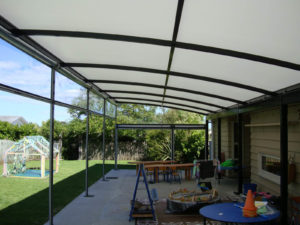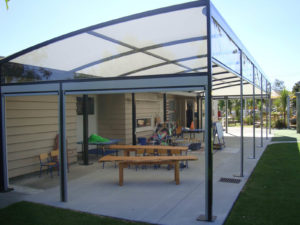
Mid-century kindergarten in New Zealand gains a contemporary facelift and enhanced enrollment—and a healthy dose of shade.
Of all the roles that shade structures fulfill—from aesthetic appeal to space expansion—
their most critical function is weather protection. Few places require as much protection against ultraviolet (UV) rays as New Zealand, which, according to the country’s Ministry of Health, has one of the highest rates of melanoma incidence in the world.
The New Zealand government expends great resources on consumer campaigns to “slip, slop, slap and wrap” (slip on a top, slop on some sun block, slap on a hat and wrap on a pair of sunglasses), explains Megan Cummins, marketing manager of Fresco Shades NZ Ltd., an outdoor shade structure manufacturer based in Auckland, New Zealand. “Schools are very aware of the dangers of UV rays and require children to wear hats when outside. This is why products like ours are so necessary; children don’t have to wear hats underneath our canopies, and teachers gain peace of mind,” Cummins says.
Fresco serves both residential and commercial markets, with a majority of its commercial projects in the education sector. “The quality of life is better when students and teachers can take their learning outdoors,” says Tony Clendon, sales manager at Fresco Shades. “Being able to help them do that year-round is really what we’re about.”
Decisions made easy
UV protection wasn’t the only challenge Fresco faced in June 2014 when installing a canopy for Torbay Kindergarten, the oldest kindergarten belonging to the Northern Auckland Kindergarten Association (NAKA), a community-owned organization regulated by the Ministry of Education. Built in the 1950s, the school offered limited sun protection in the form of a broken-down pergola. The pergola needed to be replaced with a structure that could provide more year-round usable space, and the school was in need of a face-lift to better compete with the private day care sector.
Fresco had developed a relationship with NAKA through a successful previous project, so the association didn’t look elsewhere for a company to meet the challenge, Clendon says. Four steps preceded the installation: settling on a design; conducting a site visit; completing design drawings; and submitting a building permit application to a local council accredited by the Ministry of Business, Innovation and Employment.
A modern design was chosen to create a striking contrast and give the school a more historic feel. Fresco chose two fabrics. Genclear PVC was selected for its high quality and easy-cleaning capability, and Serge Ferrari Précontraint® 702 White was selected for its light transmission qualities and high durability. Both fabrics were supplied by W Wiggins Ltd. of Auckland, New Zealand. The structure is expected to last at least 30 years, Clendon says.

Site visit surprises
The last of the original pergola’s roof had been destroyed in a recent storm, so there was pressure to build a new structure as soon as possible. However, the age of the building presented some engineering challenges that affected cost estimates.
The building’s entry was relatively low, eliminating the option for a standard arched or gable end canopy, and requiring the new canopy to open away from the school. Because no building plans existed, the existing structure couldn’t be relied on to support the new canopy. “We didn’t know where anything in the ground was,” Clendon says. “To reduce the risks to everyone involved, the engineering team conducted a complete underground inspection.”
Recommendations from the inspection included $15,000 worth of steel to construct a large portal as high and as close as possible to the kindergarten entrance on which to mount the structure, to maintain the illusion of being connected to the building. This caused a delay. “We had two and a half months with the job just sitting, waiting for a permit to be issued,” Clendon says. Time was also allotted for the school to develop and execute fundraising efforts to meet the additional expenses.
Engineers specified that the steel post be rectangular to provide strength from side to side as well as up and down. To streamline the project, Fresco typically would have hired an external company to install the post, but the company kept the extra work in-house to keep costs as low as possible.
With a freestanding structure came a new necessity: a concrete strip footing along the front of the canopy. Fresco again chose to do the work in-house. “We often have to put in concrete—either adding more or because it’s not there,” Clendon says. “In this case, we had no idea how thick it was or if the current concrete would hold, so we had to replace it all.”
Additional work included detailed sealing around gutters and downpipes to meet the client’s request for the structure to be as weatherproof as possible. No stranger to tropical cyclones, the Auckland school is located in a high wind zone.
Ongoing challenges
The question of whether the design would work aesthetically as well as functionally was an ongoing concern. With its internal resources already stretched, Fresco had hired an external company to develop 3-D renderings, which the school used to sell the idea to sponsors and stakeholders who were approached during fundraising. Because of the project’s complications, there was anxiety about whether the renderings would truly reflect the finished product. Fortunately, the 3-D illustrations were spot on, Clendon says.
Delays in council approvals prevented the installation from starting during the school holidays as planned, so the project had to be completed during normal operating hours, with weekend work done whenever possible.
Shared success
Covering a roughly 60-square-meter area, the canopy was completed in November 2014, spanning almost five months from design to installation. The structure offers protection from the sun during warmer months, and draws in direct sunlight during fall and winter. It also creates a buffer zone for the poorly insulated kindergarten, helping to reduce heating bills. “The teachers love it,” Clendon says. “They now have an outside space that can be used all 12 months—something that surprised a lot of them.”
The kindergarten’s enhanced appearance inspired the school to complete a playground remodel, expanding upon the intentional contrast between modern and historic. “It’s a really good-looking day care center now,” Clendon says. Parents appear to agree, because the school now has a full enrollment of students. To ensure proper maintenance, for a minimum fee, Fresco returns to clean its projects after the first six and 12 months, and then once a year.
Fresco has benefited also, booking future jobs with the same client as well as private jobs from parents who have seen the canopy or customers who saw images of the canopy on the company’s website. After the successful completion of a project, Clendon strongly recommends posting good photos online. “They tell a much bigger story than a whole bunch of words,” he says.
Holly Eamon is a Minneapolis-based writer and former assistant editor on the Review.
 TEXTILES.ORG
TEXTILES.ORG


